Project BM-13. Riddles and legends (BM-13-16 "Katyusha" multiple launch rocket system)
It was truly a weapon of unprecedented power - the range of the projectile reached eight and a half kilometers, and the temperature at the epicenter of the explosion was one and a half thousand degrees. The Germans repeatedly tried to seize a sample of the Russian wonder-technology, but the Katyush crews strictly complied with the rule that they could not be taken into the hands of the enemy. On a critical occasion, the machines were equipped with a self-destruct mechanism. From those legendary installations is, in fact, the entire history of the Russian rocket technology. A rocket for the "Katyusha" developed Vladimir Andreevich Artemyev.
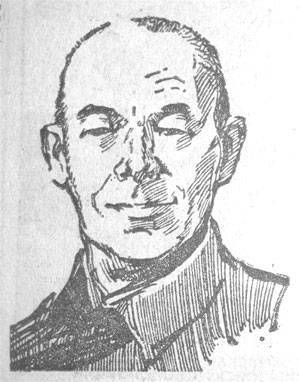 He was born in 1885 in St. Petersburg in the family of a soldier, graduated from Petersburg gymnasium and volunteered for the Russian-Japanese War. For courage and bravery, he was promoted to junior non-commissioned officer and was awarded the Cross of St. George, then graduated from the Alekseyevsky Junker School. At the beginning of 1920, Artemyev met NI Tikhomirov and became his closest assistant, but in 1922, on a wave of general suspicion towards former officers of the tsarist army, he was imprisoned in a concentration camp. Returning from Solovkov, he continued to work on improving rockets, the work on which he began in the twenties and interrupted in connection with the arrest. During the Great Patriotic War, he made many valuable inventions in the field of military equipment.
He was born in 1885 in St. Petersburg in the family of a soldier, graduated from Petersburg gymnasium and volunteered for the Russian-Japanese War. For courage and bravery, he was promoted to junior non-commissioned officer and was awarded the Cross of St. George, then graduated from the Alekseyevsky Junker School. At the beginning of 1920, Artemyev met NI Tikhomirov and became his closest assistant, but in 1922, on a wave of general suspicion towards former officers of the tsarist army, he was imprisoned in a concentration camp. Returning from Solovkov, he continued to work on improving rockets, the work on which he began in the twenties and interrupted in connection with the arrest. During the Great Patriotic War, he made many valuable inventions in the field of military equipment. After the war, V. A. Artemyev, being the chief designer of a number of research and design institutes, created new types of missiles, was awarded the Orders of the Red Banner of Labor and the Red Star, was the winner of the Stalin Prizes. Died 11 September 1962 in Moscow. His name is on the map of the moon: in memory of the creator of the "Katyusha" one of the craters on its surface was named.
“Katyusha” is the informal collective name of the BM-8 (82 mm), BM-13 (132 mm) and BM-31 (310 mm) rocket launchers. Such installations were actively used by the USSR during the Second World War.
After adoption aviation 82-mm rockets of the air-to-air class RS-82 (1937) and 132-mm rockets of the class air-to-ground RS-132 (1938) The Main Artillery Directorate set the project developer, the Reactive Research Institute, to create multiple launch rocket system based on RS-132 shells. The refined tactical and technical task was issued to the Institute in June 1938.
In accordance with this task, by the summer of 1939, the institute developed a new 132-mm high-explosive fragmentation projectile, which later received the official name M-13. In comparison with the aviation RS-132, this projectile had a longer range and a much more powerful combat unit. The increase in flight range was achieved by increasing the amount of rocket fuel, for this it was necessary to lengthen the rocket and missile head on the 48, see. The M-13 projectile had slightly better aerodynamic characteristics than the PC-132, which made it possible to obtain higher accuracy.
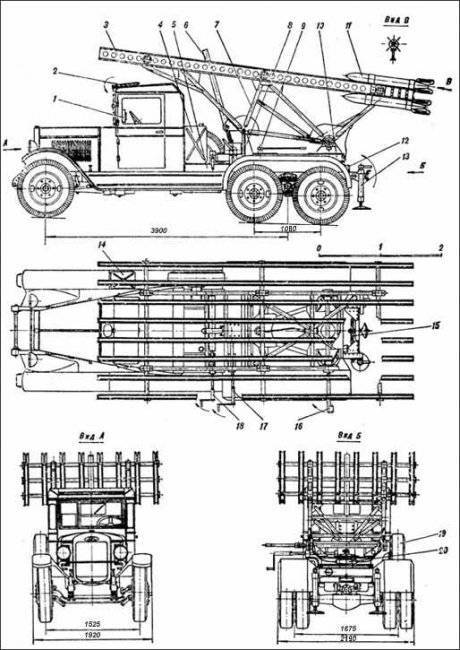
A self-propelled, multiple-charge launcher was also developed for the projectile. Its first version was created on the basis of the ZIS-5 truck and was designated MU-1 (mechanized installation, the first sample). Conducted in the period from December 1938 to February 1939, field tests of the installation showed that it does not fully meet the requirements. Taking into account the test results, the Jet Research Institute developed a new launcher MU-2, which in September 1939 was adopted by the Main Artillery Directorate for field tests. Based on the results of field tests that ended in November 1939, the institute was ordered five launchers for conducting military tests. Another installation was ordered by the Naval Artillery Directorate Fleet for use in coastal defense systems.
21 June 1941 installation was demonstrated to the leaders of the CPSU (6) and the Soviet government, and on the same day, just a few hours before the start of World War II, it was decided to urgently deploy the mass production of M-13 missiles and the launcher that received The official name of the BM-13 (13 combat vehicle).
The production of BM-13 plants was organized at the Voronezh plant named after Comintern and the Moscow plant "Compressor". One of the main enterprises for the production of rockets was the Moscow plant them. Vladimir Ilyich.
During the war, the production of launchers was urgently deployed in several enterprises with different production capabilities, and therefore more or less significant changes were made to the design of the installation. Thus, up to ten types of the BM-13 launcher were used in the troops, which hampered the training of personnel and had a negative effect on the operation of military equipment. For these reasons, a unified (normalized) BM-1943H launcher was developed and adopted in April 13. During its creation, the designers critically analyzed all parts and assemblies in order to improve the manufacturability of their production and reduce the cost, with the result that all nodes received independent indices and became universal.
Composition
The structure of BM-13 "Katyusha" includes the following military means:
Fighting vehicle (BM) MU-2 (MU-1);
Missiles.
Missile M-13:
The M-13 projectile (see diagram) consists of a warhead and a powder jet engine. The head part of its design reminds artillery high-explosive fragmentation projectile and outfitted an explosive charge, for the detonation of which a contact fuse and an additional detonator are used. The jet engine has a combustion chamber in which a powder propellant charge is placed in the form of cylindrical checkers with an axial channel. To ignite the powder charge, pyrozapals are used. The gases formed during the burning of powder checkers flow through the nozzle, in front of which there is a diaphragm preventing the emission of checkers through the nozzle. Stabilization of the projectile in flight is provided by means of a tail stabilizer with four feathers welded from stamped steel halves. (This method of stabilization provides a lower accuracy than stabilization of rotation around the longitudinal axis, however, it allows to obtain a greater range of the projectile. In addition, the use of a feathered stabilizer greatly simplifies the technology for the production of rockets).
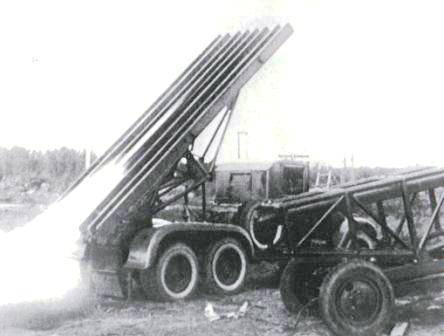
The range of the M-13 projectile reached 8470 m, but there was a very significant dispersion. According to the 1942 firing tables of the year, with 3000 m firing range, the lateral deviation was 51 m, and in range - 257 m.
In 1943, a modernized version of the missile was developed, designated M-13-UK (improved accuracy). To increase the accuracy of firing of the M-13-UK projectile, 12 tangentially located holes are made in the front centering thickening of the missile part, through which a part of the powder gases leaves the rocket engine during operation of the projectile, causing the projectile to rotate. Although the range of the projectile at the same time somewhat decreased (to 7,9 km), improved accuracy resulted in a decrease in the area of dispersion and an increase in the density of fire by 3 times as compared with M-13 projectiles. The adoption of the M-13-UK projectile into service in April 1944 contributed to a sharp increase in the firing capabilities of rocket artillery.
Launcher MLRS "Katyusha":
To projectile developed self-propelled multiply charged launcher. Its first version, the MU-1 based on the ZIS-5 truck, had 24 guides mounted on a special frame in a transverse position relative to the longitudinal axis of the car. Its design allowed launching of rockets only perpendicular to the longitudinal axis of the car, and the jets of hot gases damaged the installation elements and the ZIS-5 case. Security was also not ensured when driving from the driver’s cab. The launcher was swinging heavily, which worsened the accuracy of missile firing. Loading the launcher from the front of the rails was inconvenient and took a lot of time. The car ZIS-5 had a limited patency.
A more advanced MU-2 launcher (see diagram) based on a ZIS-6 off-road truck had 16 rails along the vehicle axis. Every two guides were connected, forming a single structure, called "Sparky". A new subframe was introduced into the installation design. The subframe allowed the assembly of the entire artillery part of the launcher (as a single unit) on it, and not on the chassis, as it was before. When assembled, the artillery unit was relatively easy to mount on the chassis of any car brand with minimal refinement of the latter. The design has made it possible to reduce the complexity, production time and cost of launchers. The weight of the artillery unit was reduced by 250 kg, the cost by more than 20 percent. The combat and operational qualities of the installation were significantly increased. Due to the introduction of the reservation of the gas tank, gas line, side and rear walls of the driver’s cabin, the survivability of launchers in combat was increased. The firing sector was increased, the stability of the launcher in the stowed position increased, improved lifting and turning mechanisms increased the speed at which the unit was aimed at the target. Before launching, the MU-2 combat vehicle was jacked up similarly to the MU-1. The forces that swing the launcher, thanks to the location of the guides along the chassis of the car, were attached along its axis to two jacks located near the center of gravity, therefore the rocking was minimal. Charging in the installation was carried out from the breech, that is, from the rear end of the guides. It was more convenient and allowed to significantly speed up the operation. The MU-2 unit had the swiveling and lifting mechanisms of the simplest design, a bracket for mounting the sight with a conventional artillery panorama and a large metal fuel tank mounted behind the cab. Cab windows were covered with armored folding shields. Opposite the seat of the commander of the combat vehicle on the front panel was mounted a small rectangular box with a turntable, resembling a telephone dial and a handle for turning the dial. This device was called the "remote control fire" (PUU). From it went the wiring harness to a special battery and to each rail.
Launcher BM-13-CH "Katyusha" on the Studebaker chassis (6x4)
With one turn of the handle of the SCP, the electrical circuit was closed, the squib was triggered, placed in front of the missile chamber of the projectile, the jet charge ignited and a shot occurred. The rate of fire was determined by the rate of rotation of the handle of the SCP. All 16 shells could be fired in 7 — 10 seconds. The transfer time of the MU-2 launcher from traveling to combat was 2-3 minutes, the angle of vertical shelling ranged from 4 ° to 45 °, the angle of horizontal shelling was 20 °.
The design of the launcher allowed its movement in a charged state at a fairly high speed (up to 40 km / h) and rapid deployment to the firing position, which contributed to the sudden attacks on the enemy.
A significant factor that increases the tactical mobility of rocket artillery units armed with BM-13Н units is that the powerful American Studebaker US 6Х6 US truck supplied to the USSR under lend-lease was used as a base for the launcher. This car had a high permeability, provided with a powerful engine, three driving axles (wheel formula 6х6), a multiplier, a winch for self-pulling, high position of all parts and mechanisms sensitive to water. The creation of this launcher was finally completed testing the serial combat vehicle BM-13. As such, she fought to the end of the war.
Testing and operation
The first battery of field-mounted artillery, sent to the front on the night of 1 on 2 in July 1941 of the year, commanded by Captain I. Flerov, was armed with seven installations made by the Rocket Research Institute. With its first salvo in 15 hours 15 minutes 14 July 1941, the battery wiped out the Orsha railway junction along with German echelons with troops and military equipment.
The exceptional efficiency of the action of the battery of Captain I. A. Flerov and seven more such batteries formed after her contributed to the rapid increase in the rate of production of jet weapons. Already in the fall of 1941, the 45 three-battery battalions with four launchers in the battery operated on the fronts. For their weapons in the 1941, the 593 BM-13 was manufactured. With the arrival of military equipment from the industry began the formation of regiments of jet artillery, consisting of three divisions, armed with launchers BM-13 and anti-aircraft division. The regiment had 1414 manpower, 36 BM-13 launchers and 12 anti-aircraft 37-mm guns. The volley of the regiment was 576 shells caliber 132mm. At the same time, manpower and military equipment of the enemy was destroyed on an area of over 100 hectares. Officially, the regiments were called the Guards mortar regiments of artillery of the reserve of the High Command.
[media=http://rutube.ru/tracks/113202.html?v=246e25c11d0b85c1e2694c9f6e52e175]
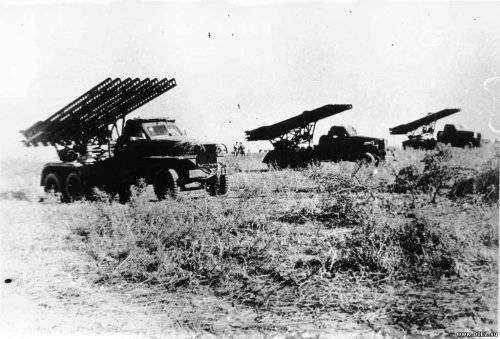
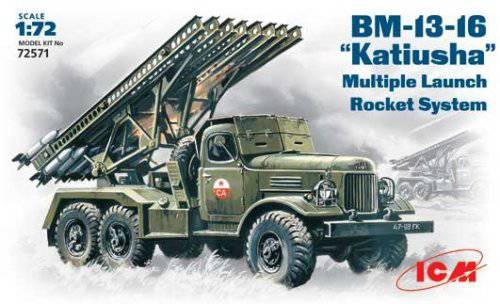
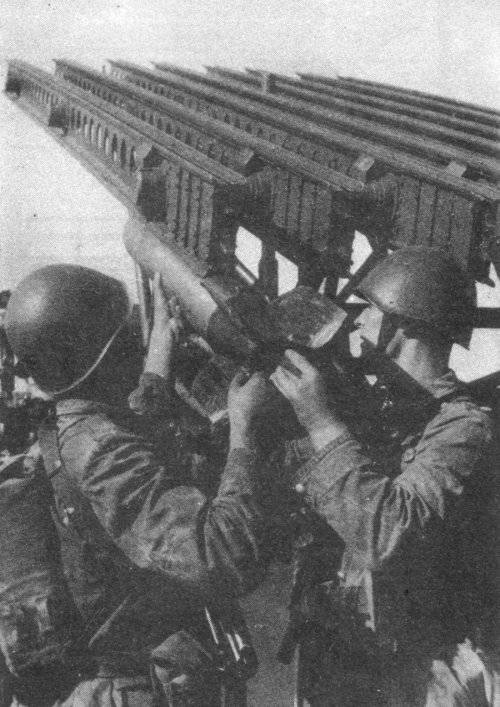
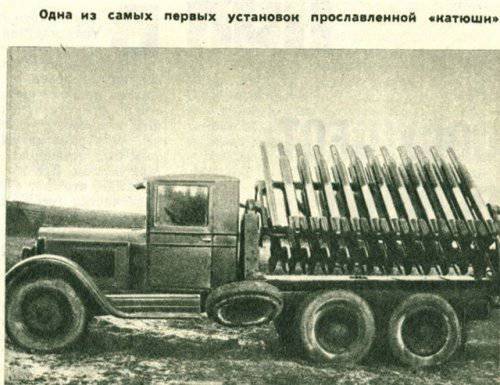
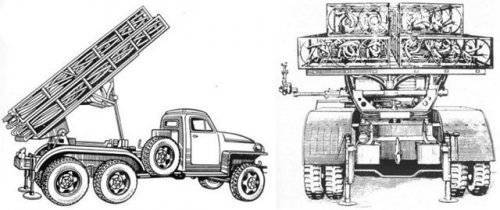
Information